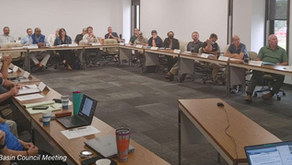Facilitation Lessons Learned: One Board, Four Board Retreats, and Four Formats
- JD Solomon
- Nov 9, 2022
- 3 min read
Updated: Nov 20, 2022

Facilitators seldom have the opportunity to use four formats with the same board of directors for four consecutive years. Blame it on COVID. In 2019 the board retreat was in-person, we were virtual in 2020, hybrid in 2021, and this year we were once again in-person.
Here are a few lessons learned.
The Overall Approach Matters
Many board retreats are no more than a string of PowerPoint presentations from department heads. Somehow, the leadership thinks the retreat should be one big information session. This approach is ineffective, and facilitators especially struggle with information-type retreats in virtual or hybrid formats.
Board retreats should be interactive because the intent is to create common understanding and synergy for the big things that need to be done in the coming year. As a facilitator, you will not struggle with the technology hand-offs and a bored board if you focus on the primary purpose.
In every format, send them the monotonous report-outs in advance and find interactive ways to cover the key information. Staff will get a little mad because they cherish their time on the stage, but the retreat is about the board and not the staff. And the board can read the details.
Five Pillars of Facilitating with FINESSE matter
The five pillars are: conduct a pre-session exchange, ask powerful questions, anticipate disruption, have engaging exercises, and roll with the ebb and flow.
For example, this board finds a pre-session survey using Microsoft Forms very useful. This retreat marks the fourth time in a row that we have used this technique. Creative ways to ask questions, using different question formats, and tying the questions to topics covered in the retreat are ways to keep the technique fresh.
Regardless of the format and experience of the facilitator, doing these five aspects well is the formula for moving from good to great.
Have a Plan B for Schedule and Content
Regardless of the format, the schedule and content will likely need an adjustment on the fly. Develop the schedule and content independently.
We organized an interactive session at this year's retreat using an audience response system (ASR) on board roles and responsibilities. The session used only two information slides and then moved into five real-world situations where each board member responded how they would handle the scenario from the perspective of the manager and as a board member.
The session was scheduled as the last of the morning because it was fun and because two earlier sessions were potentially controversial. Plan B was deleting a scenario just before lunch as an easy way to make up some time.
Both potentially controversial sessions went well and on time. However, a different session gained some unexpected interest, and more time was provided (both speakers had additional material, as planned). In the end, a modified version of Plan B, chosen by the board, was simply a pivot to a 15-minute delay in lunch rather than dropping a scenario.
Boards Love to Interact with Staff
This is not the same thing as those boring PowerPoint report-out given by each department head (avoid this – do not create a bored board).
Interaction with staff means one-on-one or small group time together. And it goes farther down than the department heads. Find ways to have the front-line employees showcase what they do or the technology they use, whether the format is in-person, hybrid, or virtual.
For the first time in four years, we were able to use six stations that allowed pairs of board members to rotate together and meet with staff. Each station covered a specific topic, had hands-on material or equipment, and included at least two staff members.
Facilitating is Relatively the Same
Facilitating board retreats requires some different tools and techniques than other types of facilitated sessions. Within the specialty of board retreats, there are a few examples where a facilitator can run the gamut of in-person, virtual, hybrid, and back to in-person with the same board. There are some powerful lessons learned, including that at its core, all facilitation is relatively the same – at least, if you know what you are doing and follow the five aspects of facilitating with FINESSE.
JD Solomon Inc provides program development, asset management, and facilitation for facilities, infrastructure, and the environment. Contact us for more information about our services related to Board Retreats, Strategic Planning, and Public Workshops,
Communicating with FINESSE is a not-for-profit community of technical professionals committed to being better communicators as trusted advisors. Join the community for free tips and guest perspectives.




Opmerkingen